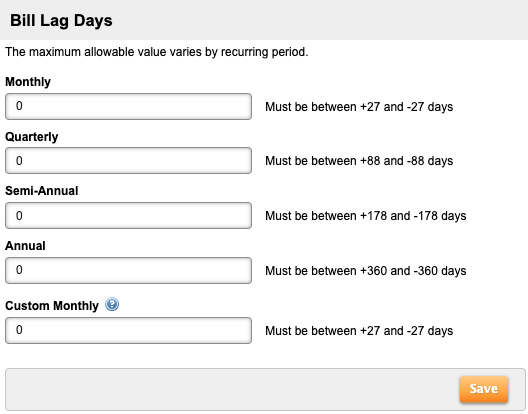Bill Lag Days
Bill lag days are the number of days prior to (negative) or after (positive) an account billing date when an invoice is generated.
Negative Bill Lag Days
Negative bill lag days are typically used for subscription-based services (often subscription-based services are paid using payment terms or net terms), in which the client wants to send invoices to customers well in advance of the actual invoice date.
This scenario gives the customer time to receive a paper or email invoice and send a payment prior to the the actual invoice date.
Note: Bill lag days only generate the invoice on a different day from the account billing date. Bill lag days do not alter the actual billing period on the account. For this reason, negative bill lag days (billed in advance) on a usage-based billing period only bill up to the date of the invoice generation.
Positive Bill Lag Days
Positive bill lag days are typically used for usage-based services.
For example, if the following conditions are true:
- Bill lag days are set to 3
- A user has usage-based services that are loaded daily
- The usage period is September 1st through September 30th
Then any usage loaded on the 1st, 2nd, or 3rd of October with a usage date in September is still included in the October invoice for recurring charges in advance and September usage charges in arrears.
Setting Bill Lag Days
Bill lag days can be set at the client level, payment method/term, collection group (also known as "collection account group"), and master plan instance.
You can specify bill lag days for several objects that are associated with a customer's account. The order of precedence is as follows:
Setting Bill Lag Days at the Client Level
Bill lag days can be set at the client level for each recurring interval. With this configuration, an annual plan can have invoices sent out 90 days in advance while a monthly plan can be constrained to a smaller window so it does not exceed the monthly recurring interval.
Getting Here: Click Configuration > Billing > Bill Lag Days
- Enter a value for each applicable recurring interval in the Value (Days) field.

- Click Save.
Aria provides a setting that allows you to set negative bill lag days in excess of one bill cycle. The value of this setting determines whether bill lag days are limited to just a maximum value or both a minimum and maximum value. See Allow Negative Bill Lag Days to Extend Beyond One Bill Cycle for more information.
Setting Bill Lag Days at the Payment Term or Payment Method
At a more granular level, you can set bill lag days on the payment method or payment term so all accounts associated with a particular payment method (for example, ACH) or payment term receive invoices either in advance of, or after, the specified billing date. Setting the bill lag days here overrides the client-level setting.
- See Add a Payment Term for instructions on setting bill lag days for a payment term.
- See Add a Payment Method for instructions on setting bill lag days for a payment method.
Setting Bill Lag Days at the Collection Group
To more precisely control billing, you can set bill lag days at the collection group (also known as "collection account group") to ensure a specific grouping of accounts receives invoices in advance of, or after, the billing date. See Create a Collection Group for instructions on setting bill lag days for a collection group. Setting the bill lag days here overrides the client-level setting and payment term/payment method bill lag days setting.
Setting Bill Lag Days at the Master Plan Instance
You can set bill lag days at the master plan instance for a specific account. This allows you to invoice a specific master plan instance on a date other than the plan's anniversary date. See Add a New Master Plan Instance to an Existing Account for instructions on setting bill lag days for a master plan instance. Setting the bill lag days here overrides all other bill lag days settings.